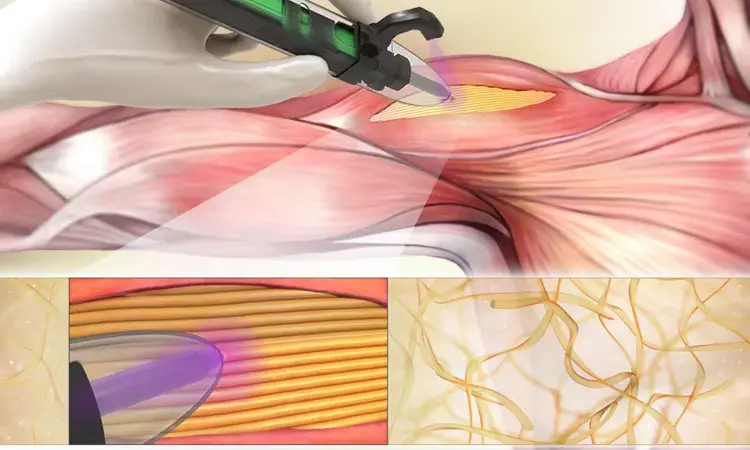- Home
- Medical news & Guidelines
- Anesthesiology
- Cardiology and CTVS
- Critical Care
- Dentistry
- Dermatology
- Diabetes and Endocrinology
- ENT
- Gastroenterology
- Medicine
- Nephrology
- Neurology
- Obstretics-Gynaecology
- Oncology
- Ophthalmology
- Orthopaedics
- Pediatrics-Neonatology
- Psychiatry
- Pulmonology
- Radiology
- Surgery
- Urology
- Laboratory Medicine
- Diet
- Nursing
- Paramedical
- Physiotherapy
- Health news
- Fact Check
- Bone Health Fact Check
- Brain Health Fact Check
- Cancer Related Fact Check
- Child Care Fact Check
- Dental and oral health fact check
- Diabetes and metabolic health fact check
- Diet and Nutrition Fact Check
- Eye and ENT Care Fact Check
- Fitness fact check
- Gut health fact check
- Heart health fact check
- Kidney health fact check
- Medical education fact check
- Men's health fact check
- Respiratory fact check
- Skin and hair care fact check
- Vaccine and Immunization fact check
- Women's health fact check
- AYUSH
- State News
- Andaman and Nicobar Islands
- Andhra Pradesh
- Arunachal Pradesh
- Assam
- Bihar
- Chandigarh
- Chattisgarh
- Dadra and Nagar Haveli
- Daman and Diu
- Delhi
- Goa
- Gujarat
- Haryana
- Himachal Pradesh
- Jammu & Kashmir
- Jharkhand
- Karnataka
- Kerala
- Ladakh
- Lakshadweep
- Madhya Pradesh
- Maharashtra
- Manipur
- Meghalaya
- Mizoram
- Nagaland
- Odisha
- Puducherry
- Punjab
- Rajasthan
- Sikkim
- Tamil Nadu
- Telangana
- Tripura
- Uttar Pradesh
- Uttrakhand
- West Bengal
- Medical Education
- Industry
Handheld 3D printers developed to treat musculoskeletal injuries

Current methods for reconstructive surgery remain inadequate for the treatment of volumetric muscle loss (VML). The geometry of skeletal muscle defects in VML injuries varies on a case-by-case basis. Three-dimensional (3D) printing has emerged as one strategy that enables the fabrication of scaffolds that match the geometry of the defect site
Lately, the researchers have developed 3D printing technology that has emerged as an up and coming solution to help reconstruct muscle.Dr Ali Tamayol, associate professor in the School of Dental Medicine biomedical engineering department has developed a bioprinter that enables surgeons to deposit scaffolds -- or materials to help support cellular and tissue growth -- directly into the defect sites within weakened skeletal muscles.
The research has been published in the American Chemical Society journal.
"The printer is robust and allows proper filling of the cavity with fibrillar scaffolds in which fibres resemble the architecture of the native tissue," says Tamayol.
The scaffolds from the bioprinter adhere precisely to the surrounding tissues of the injury and mimic the properties of the existing tissue -- eliminating the need for any suturing.
Dr. Indranil Sinha, a plastic surgeon at Brigham and Women's Hospital at Harvard joined Tamayol in this research study. With expertise in treatment of muscle injuries, Sinha says that a "good solution currently does not exist for patients who suffer volumetric muscle loss. A customizable, printed gel establishes the foundation for a new treatment paradigm can improve the care of our trauma patients."
Existing 3D bioprinting technology is not without its problems. Implanting the hydrogel-based scaffolds successfully requires a very specific biomaterial to be printed that will adhere to the defect site. While 3D bioprinted scaffolds mimicking skeletal muscles have been created in vitro, they have not been successfully used on an actual subject.
Tamayol's solution fixes the problem. Tamayol's bioprinter prints gelatin-based hydrogels -- known as "bioink" -- that have been proven to be effective in adhering to defect sites of mice with volumetric muscle loss injury. The mice showed a significant increase in muscle hypertrophy following Tamayol's therapy.
"This is a new generation of 3D printers than enables clinicians to directly print the scaffold within the patient's body," said Tamayol. "Best of all, this system does not require the presence of sophisticated imaging and printing systems."
For further reference please log on to:http://dx.doi.org/10.1021/acsabm.9b01176
Medical Dialogues Bureau consists of a team of passionate medical/scientific writers, led by doctors and healthcare researchers. Our team efforts to bring you updated and timely news about the important happenings of the medical and healthcare sector. Our editorial team can be reached at editorial@medicaldialogues.in.
Dr Kamal Kant Kohli-MBBS, DTCD- a chest specialist with more than 30 years of practice and a flair for writing clinical articles, Dr Kamal Kant Kohli joined Medical Dialogues as a Chief Editor of Medical News. Besides writing articles, as an editor, he proofreads and verifies all the medical content published on Medical Dialogues including those coming from journals, studies,medical conferences,guidelines etc. Email: drkohli@medicaldialogues.in. Contact no. 011-43720751


